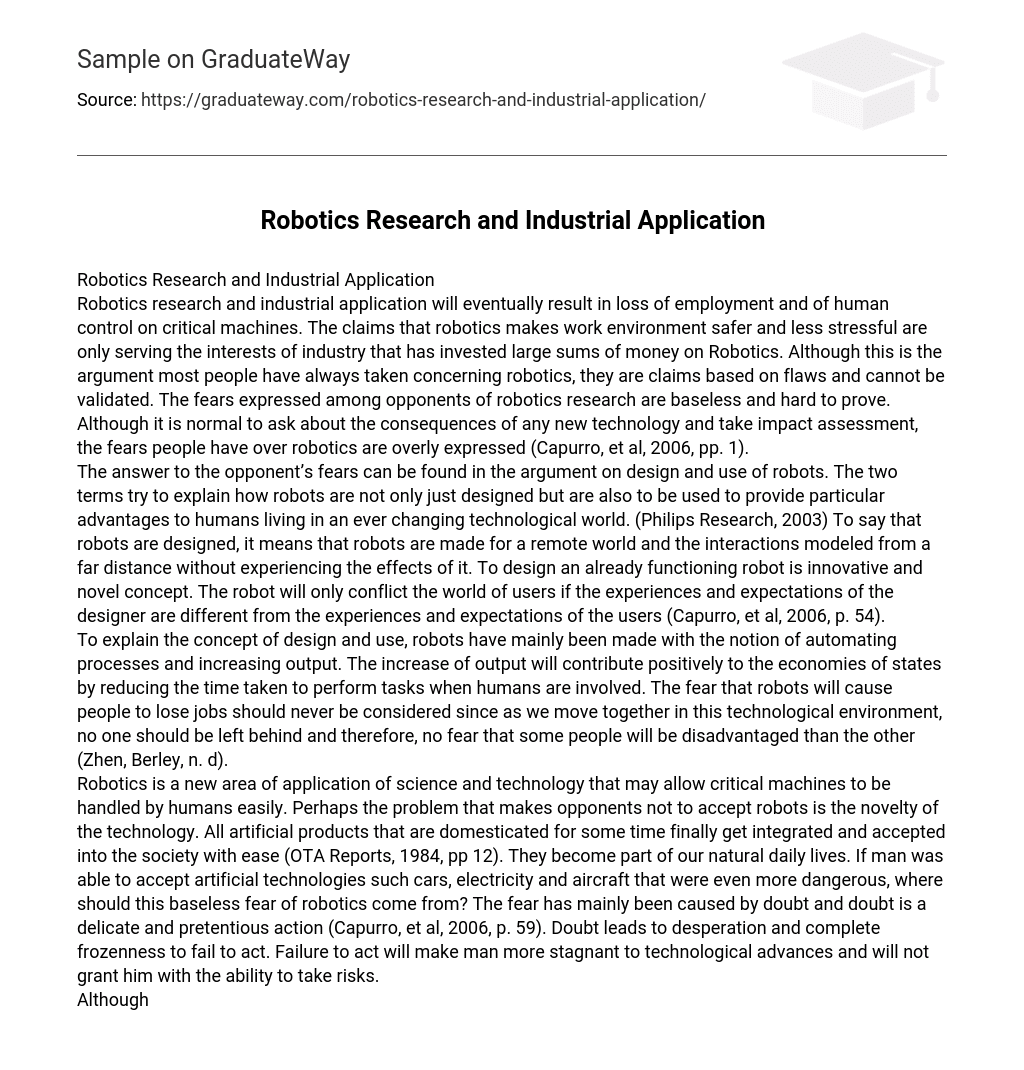Robotics research and industrial application will eventually result in loss of employment and of human control on critical machines. The claims that robotics makes work environment safer and less stressful are only serving the interests of industry that has invested large sums of money on Robotics. Although this is the argument most people have always taken concerning robotics, they are claims based on flaws and cannot be validated. The fears expressed among opponents of robotics research are baseless and hard to prove. Although it is normal to ask about the consequences of any new technology and take impact assessment, the fears people have over robotics are overly expressed (Capurro, et al, 2006, pp. 1).
The answer to the opponent’s fears can be found in the argument on design and use of robots. The two terms try to explain how robots are not only just designed but are also to be used to provide particular advantages to humans living in an ever changing technological world. (Philips Research, 2003) To say that robots are designed, it means that robots are made for a remote world and the interactions modeled from a far distance without experiencing the effects of it. To design an already functioning robot is innovative and novel concept. The robot will only conflict the world of users if the experiences and expectations of the designer are different from the experiences and expectations of the users (Capurro, et al, 2006, p. 54).
To explain the concept of design and use, robots have mainly been made with the notion of automating processes and increasing output. The increase of output will contribute positively to the economies of states by reducing the time taken to perform tasks when humans are involved. The fear that robots will cause people to lose jobs should never be considered since as we move together in this technological environment, no one should be left behind and therefore, no fear that some people will be disadvantaged than the other (Zhen, Berley, n. d).
Robotics is a new area of application of science and technology that may allow critical machines to be handled by humans easily. Perhaps the problem that makes opponents not to accept robots is the novelty of the technology. All artificial products that are domesticated for some time finally get integrated and accepted into the society with ease (OTA Reports, 1984, pp 12).
They become part of our natural daily lives. If man was able to accept artificial technologies such cars, electricity and aircraft that were even more dangerous, where should this baseless fear of robotics come from? The fear has mainly been caused by doubt and doubt is a delicate and pretentious action (Capurro, et al, 2006, p. 59). Doubt leads to desperation and complete frozenness to fail to act. Failure to act will make man more stagnant to technological advances and will not grant him with the ability to take risks.
Although robotics has taken good sums of money in research and development (R&D), the driving force of robotics research and application is not monetary. Man should try to solve his problems that face him in everyday life. The robots in Japan are not meant to collect any revenue but to test the technology that can be used in the future in a sustainable manner. Robots have been used in Japan to improve cognitive skills among children who have relatively low cognitive skills. If we become resistant to the technology, then we shall surely remain at the point where we are forever. Early scientists took risks and made great discoveries which we use today. What if these scientists did not take risks, could there be radiotherapy in cancer treatment?
Bibliography
- Berger, C.2003. Anatomy of a robot. New York. McGraw- Hill Capurro, et al 2006. Ethics in Robotics. International Review of Information Ethics. Vol. 6. pp 1-97.
- OTA Reports 1984. Computerized manufacturing automation employment, education and the workplace. Washington: US GPO.
Philips Research 2003. 365 days – Ambient Intel-ligence research in HomeLab http://www.http.com//www.research.philips.com/technologies/misc/homelab/downloads/homelab_365.pdf - Zheng, F & Berley n. d. Robots for Biological and Medical applications. World Technology Evaluation Centre. Retrieved May 2010 from: http://www.wtec.org/robotics/workshop/PDF/06-BiologicalApplications-Zheng.pdf





